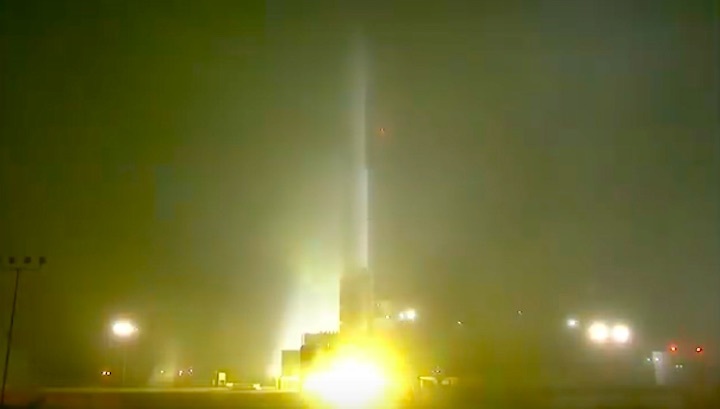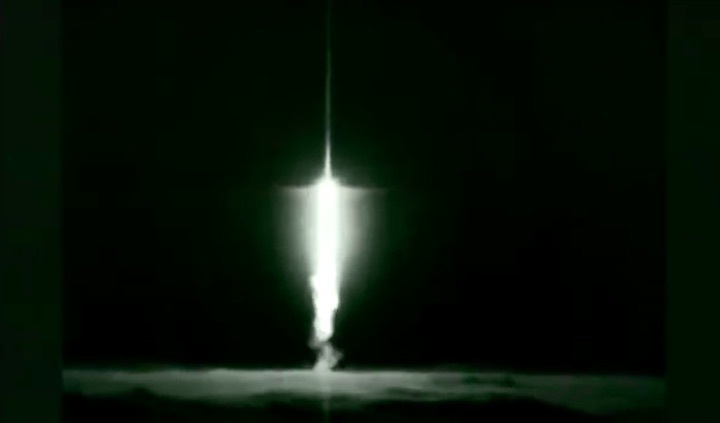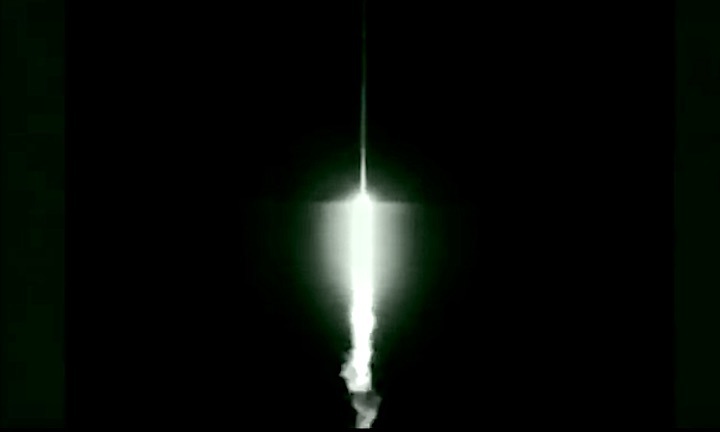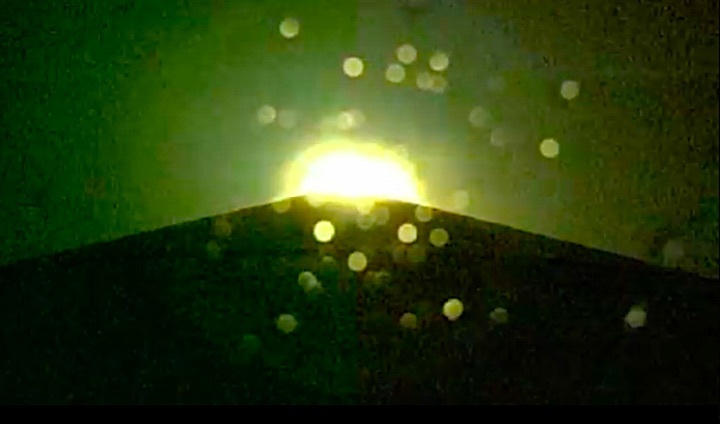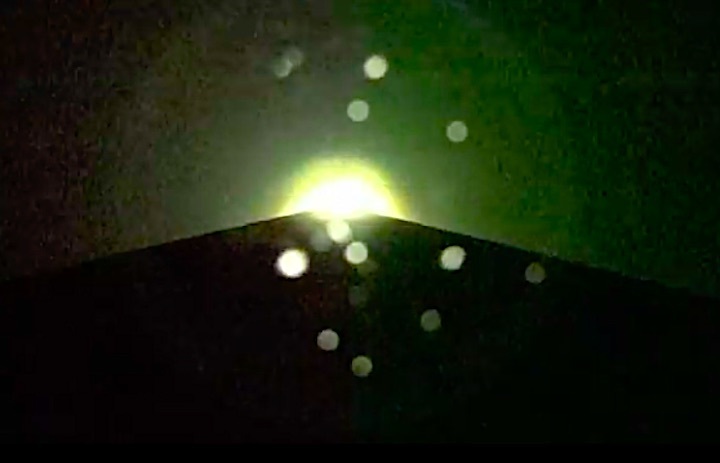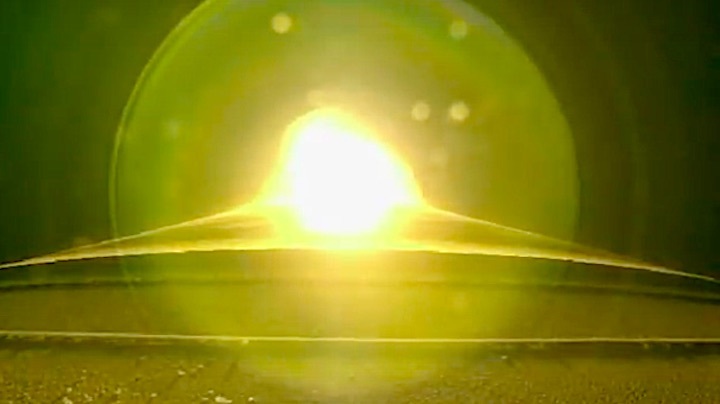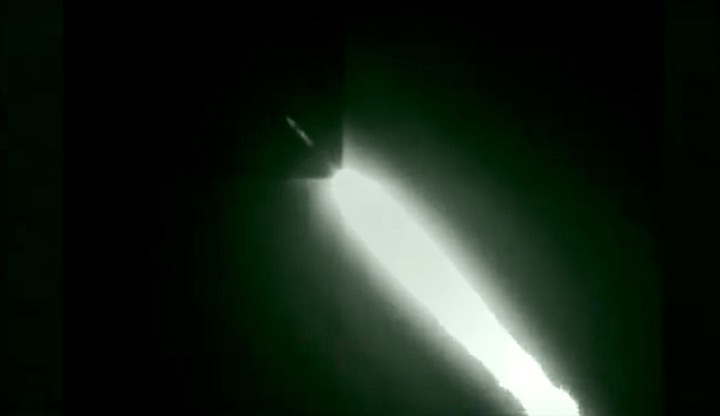2.05.2018
Atlas V Rocket Ready to Carry Vandenberg AFB’s First Mars Mission
Launch of InSight spacecraft expected to attract thousands of spectactors to Lom
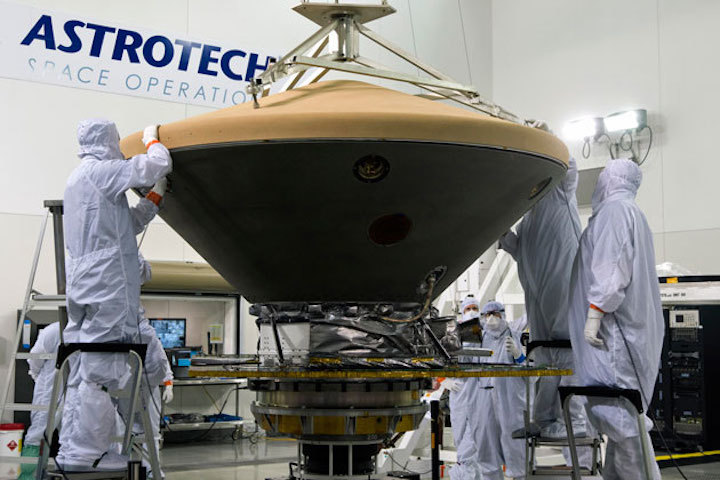
n the Astrotech facility at Vandenberg Air Force Base, the heatshield is placed on NASA’s Interior Exploration using Seismic Investigations, Geodesy and Heat Transport, or InSight, Mars lander. (Chris Wiant / USAF 30th Space Wing photo)
-
Vandenberg Air Force Base's first interplanetary mission — a NASA lander headed to Mars — has generated a lot of attention and high anticipation as launch day nears for the Atlas V rocket and its InSight spacecraft.
Liftoff of the rocket, standing approximately 190 feet tall and built by United Launch Alliance, is planned during a two-hour window opening at 4:05 a.m. Saturday when it is scheduled to blast off from South Base’s Space Launch Complex-3.
“This should be quite spectacular because it is an early morning hour, so it should light up the sky and be very visible throughout pretty much all of Southern California, even down into Mexico,” said Tom Hoffman, InSight project manager at the Jet Propulsion Laboratory.
Sitting inside the rocket’s payload fairing is NASA’s InSight, which stands for Interior Exploration using Seismic Investigations, Geodesy and Heat Transport. The spacecraft sports a seismometer, cameras and other instruments.
Officials said the mission will study the Red Planet’s deep interior with three experiments that could let scientists learn more about marsquakes and ultimately provide information about Earth.
“In essence it will take the vital signs of Mars — its pulse, temperature and much more. We like to say it’s the first thorough check up since the planet formed four and a half billion years ago,” said Thomas Zurbuchen, associate administrator for the Science Mission Directorate at NASA Headquarters.
While excitement is high, he also noted the big challenge presented by such missions once they reach the Red Planet.
“There’s something we always remind ourselves here at NASA — exploring Mars is really hard,” said Zurbuchen. “In fact, nothing is more difficult in robotic planetary exploration than landing on Mars.”
Regardless of when the rocket blasts off, the spacecraft is expected to touch down Nov. 26 after what Hoffman called “seven minutes of terror” awaiting the craft’s travels through the Mars atmosphere.
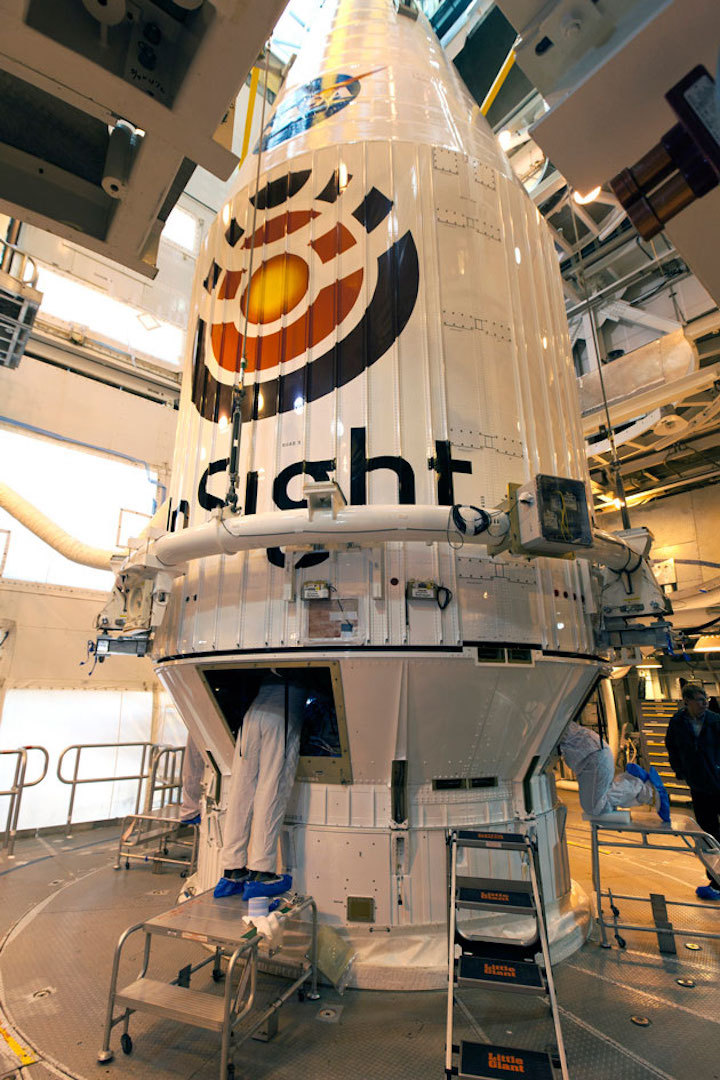
At Space Launch Complex 3 at Vandenberg Air Force Base, NASA’s Interior Exploration using Seismic Investigations, Geodesy and Heat Transport, or InSight, Mars lander has been mated atop a United Launch Alliance Atlas V rocket. (Leif Heimbold / USAF 30th Space Wing photo)
-
InSight, built by Lockheed Martin Corp., boasts other ties to Santa Barbara County. The unique solar array for InSight was designed and built by Orbital ATK-Goleta,which has seen its components fly on other Mars missions.
InSight doesn’t just involve Americans, with international partners from France, Germany, Switzerland and United Kingdom taking part.
“I don’t think you can imagine just how excited I am,” said Bruce Banerdt, InSight principal investigator at JPL.
This Mars mission is something he dreamed about and devoted 30 years of his career to refining the concept and getting it ready to take off, Banerdt said.
Due to celestial mechanics, this mission has until June 8 to get off the ground. If it misses the window, the mission would have to wait another 26 months for the next opportunity to reach the Mars.
The launch also comes as employees represented by the International Association of Machinists are poised to vote on whether to accept the final contract offer from ULA or authorize a strike on Sunday for 600 members in local lodges based at Vandenberg, the East Coast launch site Cape Canaveral, Fla. and rocket manufacturing facility in Decatur, Alabama.
“The skilled men and women at United Launch Alliance are taking a stand to save the U.S. space industry,” said Machinists Union International President Robert Martinez Jr. “Machinists Union members made ULA into the industry leader it is today. We refuse to be disrespected."
ULA representatives say they have a contingency if a strike occurs to ensure the firm meets it commitments to customers.
“We have a plan in place to help mitigate the strike’s impact, and that plan would be implemented at that time,” spokeswoman Jessica Rye said.
Instead of a handful of media members normally hosted for Vandenberg missions, some 178 members have received credentials for Saturday's planned liftoff.
The 14 previous Atlas V rocket launches, or the hundreds of other rockets and missiles to blastoff from from Vandenberg, didn’t spark this much interest.
The Santa Maria and Lompoc valleys also are home to assorted exhibits and presentations leading up to Saturday’s departure.
A large number of spectators also is expected with two off-base viewing sites set up for crowds — at the Lompoc City Airport at 1801 North H St., with parking off O Street; and St. Mary's Episcopal Church parking lot at 2800 Harris Grade Road.
Guests should arrive after 2:30 a.m. InSight team representatives will be available to answer questions, city officails said.
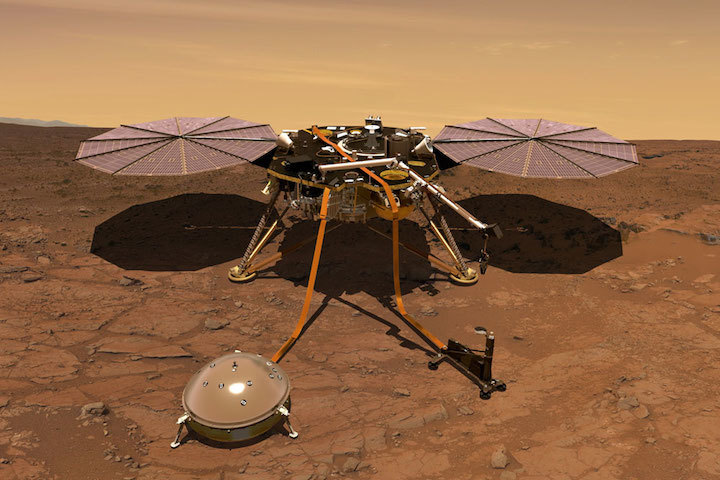
An artist’s rendition of the InSight lander operating on the surface of Mars InSight, short for Interior Exploration using Seismic Investigations, Geodesy and Heat Transport, is a lander designed to give Mars its first thorough check up since it formed 4.5 billion years ago. (NASA image)
Quelle: Noozhawk
---
Update: 4.05.2018
,
Anticipation is building as preparations are well underway for the launch of NASA’s next Mars mission, InSight. But before the roar of the rocket lifting off from Vandenberg Air Force Base has subsided, a NASA team will be hard at work preparing for the lander’s eventual plunge through the Martian atmosphere.
Experts from NASA’s Langley Research Center are key to providing modeling and computer simulations, which will be used by the InSight entry, descent and landing (EDL) team led by NASA’s Jet Propulsion Laboratory along with Lockheed Martin Space and NASA’s Ames Research Center.
Since early missions, such as Viking in 1976, Langley has played a central role in EDL simulations. The Langley group, led by Rob Maddock with Carlie Zumwalt, Alicia Dwyer Cianciolo, and Daniel Litton, is continuing that job today, building on previous projects including the Mars Science Laboratory, one of the largest and most complicated landings so far, and Phoenix, which is very similar to InSight.
“EDL has historically been a NASA Langley role in missions, ever since Viking, we’ve been known as ‘the center’ for EDL simulations,” Maddock said.
And it’s not an easy job. It’s difficult to land on other planets, there are a lot of factors, and EDL performance assessment seeks to accurately predict what conditions will be like.
“We run simulations given all of the unknowns so that we can safely land where we want to,” Maddock said. “The atmosphere is the biggest uncertainty.”
The team has been running through as many possible scenarios as possible, using unique simulations first developed during the 1960s that have been validated and updated with experience. After launch, however, they will be able to verify their models against the actual performance.
During the six-month flight to Mars, the team will acquire data allowing them to add current conditions to their models and simulations, replacing some of the unknowns and estimates. There are opportunities to make adjustments to the trajectory and the flight software starting about a month after launch all the way up to entry into the Martian atmosphere. The data collected during flight analyses will help inform the decision to make any potential modifications.
InSight's launch period is May 5 through June 8, 2018. Whichever date the launch occurs, InSight's landing on Mars is planned for Nov. 26, 2018, around 3 p.m. EST.
The team will support operations at landing. EDL begins when the spacecraft arrives about 80 miles above the surface of Mars and ends after about six minutes with the lander safe on the ground.
For InSight, this phase will be very similar to NASA’s Phoenix Mars Lander with a few key differences. InSight will enter the atmosphere at a higher velocity than Phoenix and has more mass. It will also land at a higher elevation so it has less atmosphere to use for deceleration, and the area is prone to dust storms. To address these challenges, InSight uses a thicker heat shield and its parachute will open at higher speed with stronger suspension lines.
After landing, the EDL team’s job is not over. They will complete what they call ‘reconstruction.’
“We will take the data (acceleration, inertial measurement unit, trajectory) and rebuild what happened during the actual landing to try and update our simulations and build better predictions,” Maddock said.
NASA's Interior Exploration using Seismic Investigations, Geodesy, and Heat Transport (InSight) lander will study the deep interior of Mars to learn how all rocky planets formed, including Earth and its moon. The lander's instruments include a seismometer to detect marsquakes and a probe that will monitor the flow of heat in the planet's subsurface.
NASA' s Jet Propulsion Laboratory in Pasadena, California, manages InSight for NASA's Science Mission Directorate. InSight is part of NASA's Discovery Program, managed by the agency's Marshall Space Flight Center in Huntsville, Alabama. The InSight spacecraft, including cruise stage and lander, was built and tested by Lockheed Martin Space in Denver.
NASA's Launch Services Program at the agency's Kennedy Space Center in Florida provides launch management. United Launch Alliance of Centennial, Colorado, is NASA's launch service provider of the Atlas 5 rocket. A number of European partners, including France's Centre National d'Études Spatiales (CNES) and the German Aerospace Center (DLR), are supporting the InSight mission.
Quelle: NASA
+++
Hämmern in die Tiefe des Mars - Countdown für die NASA-Mission InSight
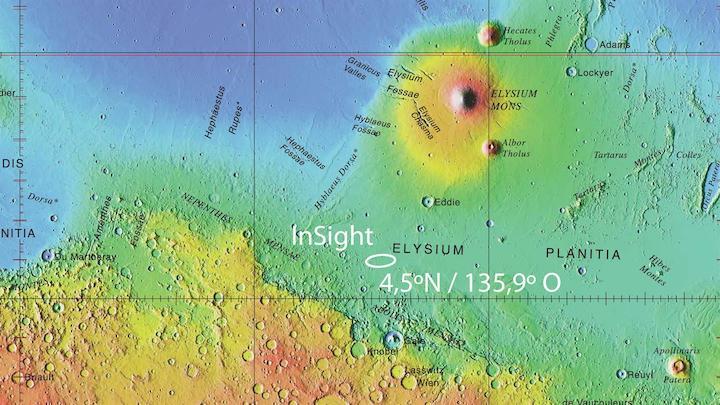
- Erkundung des Marsinneren – Bis heute sind der Aufbau des Mars und die Größe und Beschaffenheit des Marskerns nur ungenau bekannt.
- Die InSight-Mission wird neue Erkenntnisse liefern, wie sich das Marsinnere und allgemein Gesteinsplaneten wie die Erde entwickelt haben.
- Das DLR liefert deutsche Schlüsseltechnologie, die auch auf der Erde etwa beim Straßenbau in Böden oder Schüttungen an schwer zugänglichen Orten die Messung physikalischer Größen ermöglicht.
- Schwerpunkt(e): Raumfahrt, Exploration
Gebirgsbildung, Vulkanismus und Erdbeben werden durch die thermischen und mechanischen Kräfte im Inneren eines Planeten bestimmt. Auf der Erde bildeten sich Kontinente und das Leben, wie wir es heute kennen. Auf dem Mars verlangsamte sich die Dynamik der inneren Entwicklung rasch. Um das Innere des Mars und seine Vergangenheit genauer zu entschlüsseln und herauszufinden, was die Erde im Vergleich so einzigartig macht startet am 5. Mai um 13.05 Uhr MESZ (4.05 Uhr Ortszeit) eine Atlas-Trägerrakete vom kalifornischen Vandenberg mit der Raumsonde InSight an Bord zum Roten Planeten. Dort wird InSight am 26. November etwas nördlich des Äquators in der Ebene Elysium Planitia landen und seine Funktion als geophysikalisches Observatorium aufnehmen. Erstmals wird damit eine Mars-Mission als Forschungsschwerpunkt die Erkundung des Planeteninneren und seiner viereinhalb Milliarden Jahre währenden Entwicklung haben. Das Deutsche Zentrum für Luft- und Raumfahrt (DLR) steuert zur InSight-Mission der NASA mit HP3 eines der drei Hauptexperimente bei: eine kleine Rammsonde, die sich fünf Meter tief in den Marsboden hämmern wird, um dabei in unterschiedlichen Tiefen die Temperatur und die Wärmeleitfähigkeit zu messen. Zur Anwendung kam die ressourcensparende Schlüsseltechnologie aus dem DLR bereits ganz irdisch im Straßenbau in China, in der Agrarwirtschaft in Polen und in der Lawinenüberwachung in der Schweiz.
Präziseres Bild des Marsinneren und anderer erdähnlicher Gesteinsplaneten
"Die InSight Mission erfüllt einen lang gehegten Wunsch der Planetenforscher: ein geophysikalisches Observatorium auf einem erdähnlichen Planeten", erklärt Professor Tilman Spohn, der Leiter des Experiments HP3 vom DLR-Institut für Planetenforschung in Berlin. "Der Mars ist als Ziel ideal: er ist gut zu erreichen und ein ideales Vergleichsobjekt zur Erde", so Spohn weiter. Dort verlangsamten sich die Prozesse, die sich nach der Bildung eines Metallkerns im Planeteninneren und des darüber liegenden Gesteinsmantels und der Kruste abspielten, wesentlich rascher als auf der Erde. Im Mars sind deshalb möglicherweise bis heute die ‚Fingerabdrücke’ jener Vorgänge, die in den erdähnlichen Planeten Kern, Mantel und Kruste bildeten, erhalten geblieben. "Verstehen wir diese Entwicklung auf dem Mars, dann verstehen wir auch viel besser, wie sie sich auf der Erde bis hin zur Bildung und Bewahrung des Lebens abspielte und dazu wie sich Mond, Venus und Merkur entwickelten. Vielleicht lernen wir von dieser Untersuchung des Mars sogar eine ganze Menge über die Entstehung von Gesteinsplaneten an anderen Sternen, den extrasolaren Planeten", ergänzt Spohn. Gespannt sind die Forscher, ob - wie im Inneren der Erde - noch immer ein heißer, geschmolzener Kern das Zentrum des Mars bildet.
Start von der amerikanischen Westküste
Die Mission InSight (Interior Exploration using Seismic Investigations, Geodesy and Heat Transport) wurde im August 2012 als zwölfte Discovery-Mission ausgewählt. Wie alle bisherigen Missionen dieses Programms der NASA untersucht auch InSight mit einer vergleichsweise kleinen Mission ein eher spezielles Thema der Planetenforschung. Zusammen mit der Transfer-Oberstufe hat die Mission nur eine Masse von 727 Kilogramm, die eigentliche Landesonde bringt sogar nur 360 Kilogramm auf die Waage. Aus diesem Grund ist es auch möglich, die Mission vom US-Luftwaffenstützpunkt Vandenberg an der amerikanischen Westküste mit einer Atlas V-401 Trägerrakete zu starten. Es ist der erste Raketenstart einer Planetenmission von diesem NASA-Startplatz. Der Kontakt mit der Raumsonde während ihres Flugs zum Mars und während des Missionsbetriebs erfolgt über die 70-Meter-Antennen des Deep Space Networks der NASA in Kalifornien, Australien und Spanien.
Ein geophysikalisches Observatorium für den Roten Planeten
Hauptbestandteil des Landers ist eine Plattform von zwei Metern Durchmesser, auf der die meisten Systemkomponenten, die Experimente in ihrem ‚Reisemodus’, die Antennen, der Bordcomputer, die Bremstriebwerke, die Treibstofftanks und drei Teleskopbeine angebracht sind. Nach der Ankunft am Mars wird ein Roboterarm zunächst das französische Marsbeben-Observatorium SEIS (Seismic Experiment for Interior Structure) auf die Oberfläche setzen, an dem auch das DLR beteiligt ist. Das Seismometer zeichnet die von Marsbeben und Meteoriteneinschlägen ausgehenden Wellen auf, die durch den Planeten laufen. Anschließend wird um die Jahreswende 2018/19 das am DLR entwickelte Experiment HP3 von der Plattform auf den Marsboden gesetzt. HP3 ist eine Abkürzung, die für Heat Flow and Physical Properties Package steht. Das Experiment besteht aus dem auf dem Marsboden stationierten Gehäuse, der sogenannten Support-Struktur, an dessen Vorderseite eine vertikale Vorrichtung angebracht ist. Darin befindet sich eine 40 Zentimeter lange Rammsonde von 27 Millimetern Durchmesser – von den Wissenschaftlern ‚Maulwurf’ (engl. mole) genannt –, die sich mit einem elektrisch angetriebenen Hammerschlagmechanismus über mehrere Wochen Zentimeter für Zentimeter in den Marsboden treiben wird. Die Support-Struktur und der Mole wurde verantwortet vom DLR-Institut für Raumfahrtsysteme in Bremen gebaut und zusammen mit externen Partnern entwickelt. So wurde beispielsweise der Schlagmechanismus des Moles mit Unterstützung der Firma Astronika und dem Weltraumforschungszentrum der Polnischen Akademie CBK, beide in Warschau, entwickelt und gebaut. Die maximal erreichbare Tiefe beträgt fünf Meter.
Hämmern mit vierzehntausendfacher Erdbeschleunigung
Im Gegensatz zu einem Bohrer, der die Verwendung eines Bohrgestänges erforderlich macht, sorgt bei HP3 der spezielle Schlagmechanismus für den Vortrieb in den Grund. Bei diesem wird eine Feder im Mole immer wieder gespannt, die beim Lösen den Hammerschlag bewirkt. Diese Stöße verursachen heftige Beschleunigungen bis zum Vierzehntausendfachen der Erdbeschleunigung, weshalb die empfindliche Messtechnik im Inneren der Sonde durch eine spezielle Stoßdämpfung vor den auftretenden Belastungen geschützt werden muss. Bei der Konstruktion verwendete das DLR-Nutzerzentrum für Weltraumexperimente deshalb auch Systeme zur Stoß- und Schwingungsminimierung aus dem DLR-Institut für Faserverbundleichtbau und Adaptronik in Braunschweig. Das Isolationssystem entkoppelt die Sensoren von den Stößen und minimiert die Belastungen der Sensorik. Hierfür kommen speziell patentierte Doppelspiralfedern – auch „Galaxiefedern“ genannt – zum Einsatz. Neben den Schwingungsdämpfungsfedern im Mole sind Verfahren zur Bestückung der Temperatursensoren und Zuleitungen auf dem Messkabel technische Highlights, die eine Anwendung des Moles auch auf der Erde für physikalische Messungen in Böden und Schüttungen in abgelegenen Gebieten mit geringen Ressourcen interessant machen.
Flachbandkabel misst Temperaturen im Untergrund
Das ‚Herzstück’ des Experiments besteht aus einem mit Temperatursensoren bestückten Flachbandkabel, das vom Hammermechanismus in den Marsboden eingebracht wird und im DLR-Institut für Planetenforschung entwickelt wurde. Einmal im Boden werden vor Ort bis zu zwei Jahre lang Bodentemperaturmessungen durchgeführt, um das Temperaturgefälle im Untergrund zu bestimmen. Dabei können die Sensoren Temperaturdifferenzen von nur wenigen Tausendstel Grad Kelvin aufzeichnen, um so den sehr kleinen geothermischen Temperaturgradienten zu bestimmen. Zum Experiment gehört ferner das Radiometer RAD auf der Landesonde, mit dem die Temperatur der Marsoberfläche bestimmt werden kann. Die Kenntnis der Oberflächentemperatur ist von Bedeutung, um Störungen der Temperaturverteilung im Untergrund berechnen zu können. RAD wurde durch das DLR-Institut für Optische Sensorsysteme entwickelt und gebaut.
Das HP3 Instrument auf der NASA-Mission InSight
Die Mission InSight wird vom Jet Propulsion Laboratory (JPL) in Pasadena, Kalifornien, im Auftrag des Wissenschaftsdirektorats der NASA durchgeführt. InSight ist eine Mission des NASA-Discovery-Programms. Das DLR steuerte zur Mission das Experiment HP3 (Heat Flow and Physical Properties Package) bei. Die wissenschaftliche Leitung liegt beim DLR-Institut für Planetenforschung, wo das Experiment auch federführend entwickelt wurde, in Zusammenarbeit mit den DLR-Instituten für Raumfahrtsysteme, Optische Sensorsysteme, Raumflugbetrieb und Astronautentraining, Faserverbundleichtbau und Adaptronik, Systemdynamik und Regelungstechnik, sowie Robotik und Mechatronik. Daneben sind beteiligte industrielle Partner: Astronika und CBK Space Research Centre, Magson und Sonaca. Wissenschaftliche Partner sind das ÖAW Institut für Weltraumforschung und die Universität Kaiserslautern. Der Betrieb von HP3 erfolgt durch das Nutzerzentrum für Weltraumexperimente (MUSC) des DLR in Köln.
Quelle: DLR
+++
'We are go for launch': Low visibility expected for Saturday Mission to Mars, but excitement remains high
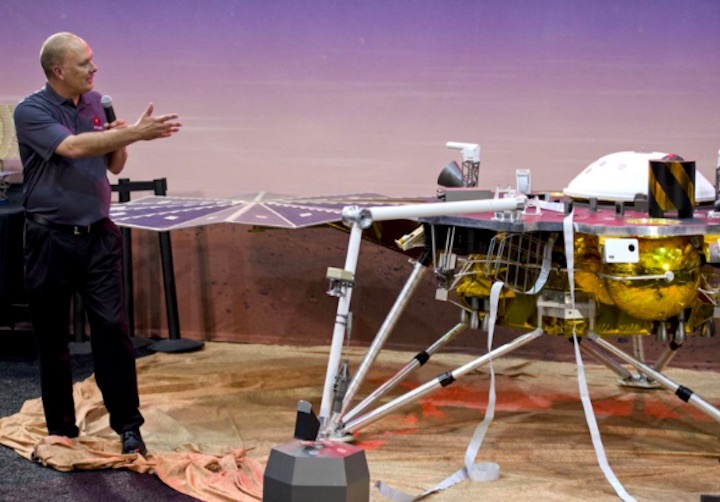
Stu Spath, a program manager with Lockheed Martin Space, said Thursday that he was recently asked if he considered NASA’s InSight Mission to Mars to be “routine.”
Given that Lockheed has been involved with 20 missions to the red planet, Spath acknowledged that the question was a fair one. To answer it, he turned to one of the most acclaimed films to ever depict space travel.
“I’ll steal a little bit from Tom Hanks here in ‘Apollo 13’ (with) slight rewording: There’s nothing routine about going to Mars, especially landing on Mars,” Spath said, substituting Mars for the moon, which was the destination in the 1995 movie and the 1970 mission it dramatized. “This is a tough mission and we’re happy to be a part of it.”
Spath made the comments during the final press briefing before Saturday morning's historic Mission to Mars launch from Vandenberg Air Force Base. The event was held in a NASA facility on base, just a couple of miles away from the actual InSight lander, which had already been stowed aboard the United Launch Alliance-built Atlas V rocket that will attempt to carry it into space at 4:05 a.m. Saturday from VAFB’s Space Launch Complex-3.
Excitement, anticipation and preparation were the main themes of the briefing, which was attended by dozens of media members, space enthusiasts, including a former NBA champion, and many of the scientists, engineers and military officials who are involved in what is set to be the first interplanetary mission ever to originate from the West Coast of the U.S.
“This is thrilling,” said Tim Dunn, the launch director with NASA’s Launch Services Program.
Launch a go
Dunn revealed during the conference that everything was on track for a Saturday liftoff. He said a flight readiness review was performed on Monday, a mission dress rehearsal was held on Tuesday, and a launch readiness review was done on Thursday.
“We got goes from all aspects, all organizations that have a vested interest in launching InSight, so we are go for launch,” he said, drawing applause from attendees. “Yes, we are.”
While most of the briefing was upbeat, there was one wet blanket. Or, more specifically, marine layer.
1st Lt. Kristina Williams, weather officer for VAFB’s 30th Space Wing, provided an update on the anticipated weather conditions for the time of the launch. Most significant in that update was that a heavy fog is expected, which will likely drastically reduce visibility of the launch from the ground.
She noted that the lack of visibility prompted her to assign a Probability of Violation, or POV, figure of 80 percent for the launch. She made clear, though, that the POV percentage doesn’t mean there’s an 80-percent chance of the launch being scrubbed on Saturday.
“It’s a common event, especially at this time of year,” she said of heavy fog in the region, “and ULA and NASA are both aware of it and they are prepared to launch through it. The constraint is for safety, but they do have ways of mitigating it. So, essentially, by assigning 80 percent, I’m saying there’s an 80-percent chance you will not be able to see the rocket launch at liftoff.”
Col. Michael Hough, the commander of the 30th Space Wing and the launch decision authority for the mission, joked that he was glad that a simulation video was shown at Thursday’s briefing so that everyone would at least be able to see what’s supposed to happen.
No matter how the view is from the ground, however, Hough won’t be able to witness it. He said that he, regrettably, will be indoors on duty watching from a console.
“I hate that I won’t actually be able to see it live,” he said.
Thousands watching
Thousands of visitors are expected to descend on the Lompoc Valley for Saturday’s launch. Two public watch parties are planned in Lompoc, with one at the Lompoc Airport and one at St. Mary’s Episcopal Church. Attendees are asked not to arrive before 2:30 a.m.
While fog might present a visibility issue for spectators during the first few minutes after the launch, almost all of the speakers at Thursday’s press conference expressed enthusiasm for all that the mission may entail well after the rocket reaches space.
Firsts for InSight
InSight will be the first-ever mission dedicated to exploring Mars’ deep interior, according to NASA, and it also will be the first NASA mission since the Apollo moon landings to place a seismometer, a device that measures quakes, on the soil of another planet.
The data that is expected to be compiled by the lander could give scientists on Earth insight into the size of Mars’ core, mantle and crust, which could then be compared to Earth and aid in the understanding of how the planets were formed.
“This is of fundamental importance for us to understand the origin of our solar system and how it became the way it is today,” said Jim Green, NASA’s chief scientist.
The mission will also allow researchers to gauge quakes and temperature changes on Mars, which could have significant implications for future human settlements on the planet.
“This mission does so many fundamental things, not only in planetary science, but in human exploration,” Green said. “And it’s a very popular mission.”
Evidence of that popularity was shown in the 2.4 million names that were added to the spacecraft after NASA put out a call for submissions. It could also be seen in the unusually large crowd that gathered for Thursday’s press briefing, a typically low-key affair.
All-star turnout
Among the attendees at the press conference was former NBA All-Star and two-time champion Chris Bosh, who tweeted photos from the event and used the hashtag #ScienceNerd, presumably describing himself.
Tom Hoffman, InSight project manager for NASA’s Jet Propulsion Laboratory, said he was “really, really excited” to see the mission finally get off the ground.
“I can’t describe to you in words how very excited I am to see us at this point — ready to go off to Mars, ready to send this to another planet,” he said, noting that he’s been a part of the mission for seven years. “It’s gonna be awesome.”
The window to launch will run from Saturday morning to June 8. If, for whatever reason, the launch does not occur during that window, it will have to be put off for 26 months due to the positioning of Earth and Mars.
With so many chances, odds are that it will indeed launch at some point in the next month, if not this weekend.
“It’s gonna be the brightest object in the sky; it should be quite spectacular,” Hoffman said. “So, set your alarms and get up and watch this if you don’t happen to be here at Vandenberg.”
The fun won’t end there, however. The InSight craft is expected to travel for roughly six months through space before reaching Mars. The anticipated landing date is Nov. 26, which is also the online retail holiday Cyber Monday.
“If you’re doing your holiday shopping and you want to see something else,” Hoffman said, “you can put that on your other screen … and you can see us land.”
Quelle: LOMPOC RECORD
---
Update: 5.05.2018 / 7.55 MESZ
.
NASA will launch its first little cubesats bound for Mars on Saturday
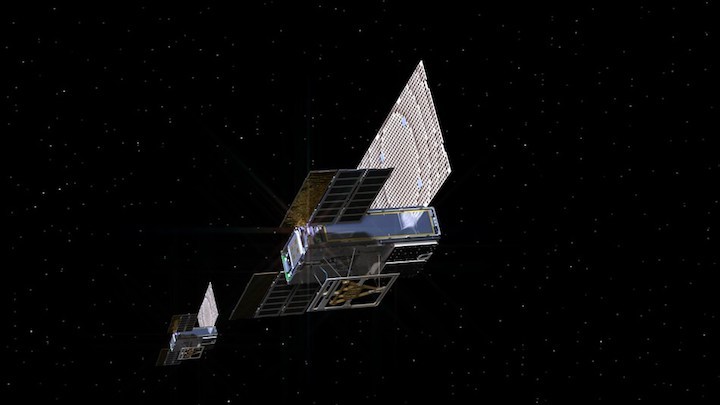
Two tiny NASA satellites nicknamed Wall-E and Eva are about to hitch a ride to Mars.
The twin, suitcase-sized spacecraft, called cubesats, will launch to space Saturday aboard the same rocket carrying NASA's InSight lander to Mars, but they'll have very different missions once they reach the red planet in November.
Cubesats, profoundly lighter and cheaper than traditional spacecraft, have never traveled millions of miles though heavily-irradiated deep space, but NASA wants to know how they'll hold up on the journey.
"Spacecraft of MarCO’s size have been developed for Earth's orbit over the last 10 or 15 years," Joel Krajewski, a NASA engineer and project manager for the MarCO mission, said in an interview. "We’re going to attempt to apply those technologies to deep space."
If the Mars-bound cubesats do happen to fail — perhaps because their electronics get fried or their antennas don't work — valuable geologic information from the InSight lander won't be lost. NASA won't solely depend on the mini satellites to communicate. Other Mars orbiters are responsible for the longer-term relay of this seismic data back to Earth, said Krajewski.

A photograph of CubeSats being shot out of the International Space Station.
IMAGE: NASA
But if the tiny satellites do successfully work, similar low-cost satellites could be sent to other distant planets and moons, making communication with Earth from these deep reaches of space easier, and in some cases, possible at all.
When NASA lands a spacecraft on another planet, scientists generally need to have a "relay satellite" to beam images and measurements back to Earth.
Space exploration is hugely expensive, and cubesats could provide a much cheaper way to relay this information back home, rather than building and launching heavy spacecraft.
"It makes missions that require relays more practical," said Krajewski.

NASA engineer Joel Steinkraus tests the solar array on a Mars Cube One cubesat.
IMAGE: NASA/JPL
Such deep-space cubesats might be sent to the intriguing outer moons in our solar system, like Europa and Enceladus, said Krajewski. Or, they could be deployed closer to home.
NASA wants to send a lander into a deep crater in the south pole of the moon, for example, a place that is physically out of sight of Earth. If we want to know what's down there, we'll need a relay satellite, he said.
The two main technologies NASA hopes to prove out on the mission are miniaturized forms of propulsion and communication.
Unlike cubesats that orbit Earth, deep space cubesats will often need to maneuver as they hurtle toward other planets. NASA is testing a technology that shoots out propellant, identical to the material you find in some fire extinguishers, to steer around space, said Krajewski. (The scientists who built the cubesats nicknamed the satellites after two fictional robots from the 2008 Pixar movie Wall-E, because Wall-E also used compressed gas to propel itself around.)

An artist's conception of the InSight lander collecting seismic data on Mars.
IMAGE: NASA
The cubesats come equipped with a radio and antenna, which will beam information back to Earth.
This, said Krajewski, will allow the satellites to relay information about the InSight lander's descent through the Martian atmosphere, including its speed, distance to the ground, and whether or not the parachute opens.
If NASA scientists receive this information from the little cubesats, it will be "the cherry on top of the mission," said Krajewski.
But first, Wall-E and Eva must survive the long journey, persisting through intensely frigid temperatures, exposure to different types of space radiation, and absorbing enough solar energy to stay powered.
"The longer you’re out there, the more likely something might happen," said Krajewski.
Quelle: Mashable
+++
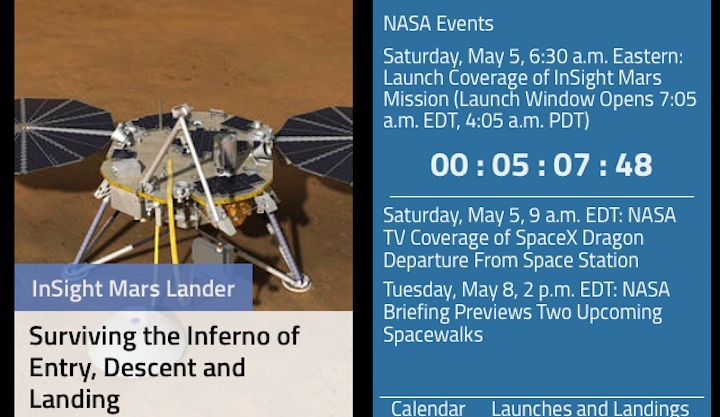
Quelle: NASA
+++
NASA Live: InSight Mars Launch
NASA’s InSight Mars mission is scheduled to launch Saturday, May 5 at 7:05 a.m. Eastern (4:05 a.m. Pacific), on a first-ever mission to study the heart of the Red Planet.
Mission status updates: InSight launch blog
Follow: @NASAInSight, @NASA
Latest images: NASA HQ Photo
NASA TV InSight Mars Schedule:
Saturday, May 5, 6:30 a.m. Eastern (3:30 a.m. Pacific): InSight Mars launch coverage. Launch window opens at 7:05 a.m. EDT (4:05 a.m. PDT).
Watch NASA TV Live:
Upcoming Events Airing Live (all times Eastern)
Saturday, May 5, 6:30 a.m.: Launch coverage: InSight Mars Lander. Launch is at 7:05 a.m. InSight (Interior Exploration using Seismic Investigations, Geodesy and Heat Transport), the first mission to explore Mars' deep interior, is scheduled to launch May 5, 2018, from Vandenberg Air Force Base in California on a ULA Atlas V rocket. This will be the first interplanetary launch from the West coast of the United States. Launching on the same rocket is a separate NASA technology experiment known as Mars Cube One (MarCO). MarCO consists of two mini-spacecraft and will be the first test of CubeSat technology in deep space.
Saturday, May 5, 9 a.m.: NASA TV coverage of Dragon departure from space station. SpaceX's CRS-14 Dragon cargo spacecraft is released from the International Space Station, after which it will return to Earth and splash down. Release is scheduled at approximately 9:30 a.m. EDT.
Quelle: NASA
+++
NASA, ULA Launch Mission to Study How Mars Was Made
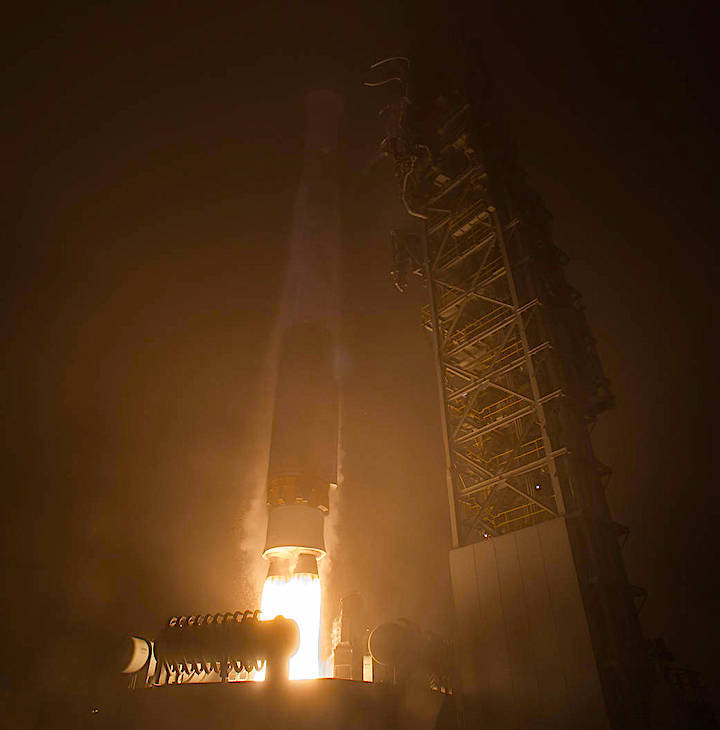
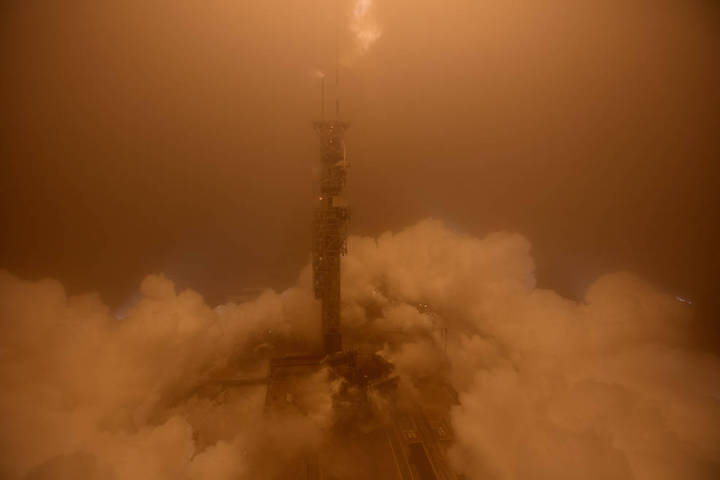
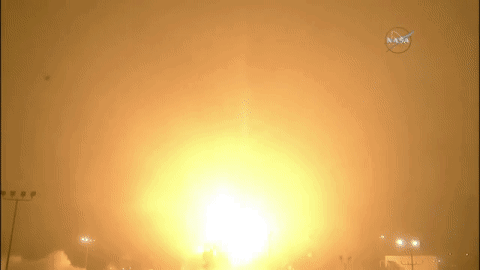
NASA’s Mars Interior Exploration using Seismic Investigations, Geodesy and Heat Transport (InSight) mission is on a 300-million-mile trip to Mars to study for the first time what lies deep beneath the surface of the Red Planet. InSight launched at 7:05 a.m. EDT (4:05 am PDT) Saturday from Vandenberg Air Force Base, California.
“The United States continues to lead the way to Mars with this next exciting mission to study the Red Planet’s core and geological processes,” said NASA Administrator Jim Bridenstine. “I want to congratulate all the teams from NASA and our international partners who made this accomplishment possible. As we continue to gain momentum in our work to send astronauts back to the Moon and on to Mars, missions like InSight are going to prove invaluable.”
First reports indicate the United Launch Alliance (ULA) Atlas V rocket that carried InSight into space was seen as far south as Carlsbad, California, and as far east as Oracle, Arizona. One person recorded video of the launch from a private aircraft flying along the California coast.
Riding the Centaur second stage of the rocket, the spacecraft reached orbit 13 minutes and 16 seconds after launch. Seventy-nine minutes later, the Centaur ignited a second time, sending InSight on a trajectory towards the Red Planet. InSight separated from the Centaur 14 minutes later – 93 minutes after launch – and contacted the spacecraft via NASA’s Deep Space Network at 8:41 a.m. EDT (5:41 PDT).
“The Kennedy Space Center and ULA teams gave us a great ride today and started InSight on our six-and-a-half-month journey to Mars,” said Tom Hoffman, InSight project manager at NASA’s Jet Propulsion Laboratory (JPL) in Pasadena, California. “We’ve received positive indication the InSight spacecraft is in good health and we are all excited to be going to Mars once again to do groundbreaking science.”
With its successful launch, NASA’s InSight team now is focusing on the six-month voyage. During the cruise phase of the mission, engineers will check out the spacecraft’s subsystems and science instruments, making sure its solar arrays and antenna are oriented properly, tracking its trajectory and performing maneuvers to keep it on course.
InSight is scheduled to land on the Red Planet around 3 p.m. EST Nov. 26, where it will conduct science operations until Nov. 24, 2020, which equates to one year and 40 days on Mars, or nearly two Earth years.
“Scientists have been dreaming about doing seismology on Mars for years. In my case, I had that dream 40 years ago as a graduate student, and now that shared dream has been lofted through the clouds and into reality,” said Bruce Banerdt, InSight principal investigator at JPL.
The InSight lander will probe and collect data on marsquakes, heat flow from the planet’s interior and the way the planet wobbles, to help scientists understand what makes Mars tick and the processes that shaped the four rocky planets of our inner solar system.
“InSight will not only teach us about Mars, it will enhance our understanding of formation of other rocky worlds like Earth and the Moon, and thousands of planets around other stars,” said Thomas Zurbuchen, associate administrator for NASA’s Science Mission Directorate at the agency headquarters in Washington. "InSight connects science and technology with a diverse team of JPL-led international and commercial partners."
Previous missions to Mars investigated the surface history of the Red Planet by examining features like canyons, volcanoes, rocks and soil, but no one has attempted to investigate the planet's earliest evolution, which can only be found by looking far below the surface.
“InSight will help us unlock the mysteries of Mars in a new way, by not just studying the surface of the planet, but by looking deep inside to help us learn about the earliest building blocks of the planet,” said JPL Director Michael Watkins.
JPL manages InSight for NASA's Science Mission Directorate. InSight is part of NASA's Discovery Program, managed by the agency's Marshall Space Flight Center in Huntsville, Alabama. The InSight spacecraft, including cruise stage and lander, was built and tested by Lockheed Martin Space in Denver. NASA's Launch Services Program at the agency's Kennedy Space Center in Florida is responsible for launch service acquisition, integration, analysis, and launch management. United Launch Alliance of Centennial, Colorado, is NASA's launch service provider.
A number of European partners, including France's Centre National d'Études Spatiales (CNES) and the German Aerospace Center (DLR), are supporting the InSight mission. CNES provided the Seismic Experiment for Interior Structure (SEIS) instrument, with significant contributions from the Max Planck Institute for Solar System Research (MPS) in Göttingen, Germany. DLR provided the Heat Flow and Physical Properties Package (HP3) instrument.
+++
Liftoff of InSight
